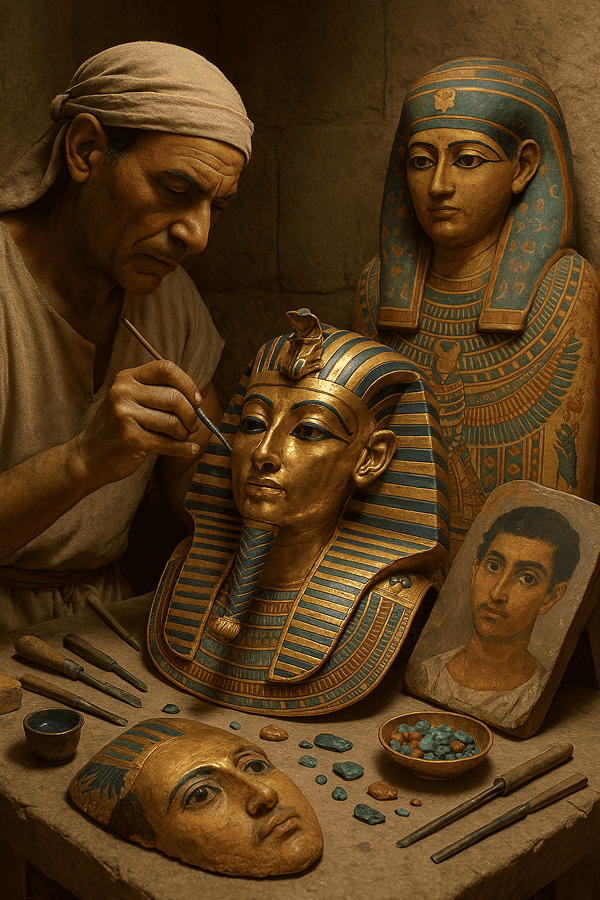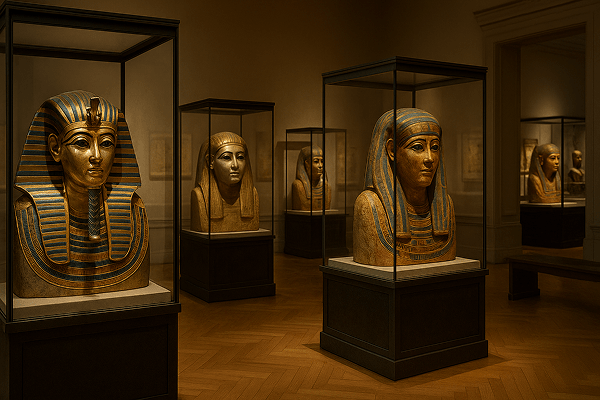Ancient Egyptian funeral masks are among the most iconic artifacts of human history, instantly recognizable for their striking appearance and deep spiritual significance. Crafted to cover the face of the deceased, these masks typically display idealized human features, often rendered in gold and adorned with inlays of colored glass, gemstones, and intricate patterns. Their most characteristic elements include almond-shaped eyes, serene expressions, and the use of royal or divine iconography — such as the striped nemes headdress and false beard, especially on masks of pharaohs. Originating in the Nile Valley, funeral masks were used throughout Egyptian history, from the Old Kingdom (c. 2686–2181 BCE) through the Greco-Roman period, serving as both protective amulets and representations of the deceased in the afterlife.
Historical Origins of Ancient Egyptian Funeral Masks
The origins of Egyptian funeral masks are deeply rooted in the civilization’s beliefs about death and the afterlife. The ancient Egyptian word for mask, “māsket” (transliterated), reflects both its covering function and its ritual importance. Early masks, dating to the Predynastic and Old Kingdom periods, were simple and crafted from materials like wood and plaster. As religious beliefs evolved, so did the masks’ design and function. The rise of the cult of Osiris and the widespread adoption of mummification in the Middle Kingdom (c. 2055–1650 BCE) led to increasingly elaborate masks, culminating in the extraordinary gold masks for royalty and nobility of the New Kingdom and beyond. Notable historical mentions include the famous golden mask of Tutankhamun (c. 1323 BCE), discovered in 1922 by Howard Carter, which instantly became a symbol of Egypt’s ancient grandeur. Over time, Egyptian masks evolved from simple funerary coverings to highly sophisticated works of art, embodying changing concepts of divinity, kingship, and the soul’s journey.
Cultural Significance and Symbolism of Egyptian Funeral Masks
In ancient Egyptian culture, funeral masks were not merely decorative — they held profound symbolic and religious meaning. The mask served to protect the deceased’s face, ensuring that the soul (ka) could recognize its body and thus be reborn in the afterlife. Crafted with idealized features, often modeled after the gods, the mask connected the deceased with divine protection, particularly that of Osiris, the god of the dead. Myths and funerary texts, including the Book of the Dead, reference the mask as a shield against evil forces and a guarantee of immortality. Socially, the use of masks signaled status and lineage; only those of sufficient rank could afford the most elaborate and precious examples. In the broader cultural context, funeral masks reinforced the Egyptian worldview of order, regeneration, and the cyclical nature of life and death.
Materials and Craft Techniques of Ancient Egyptian Funeral Masks
The materials and techniques used in crafting funeral masks reflect both the artistic ingenuity and the spiritual priorities of ancient Egypt. Royal masks, such as that of Tutankhamun, were made primarily from beaten gold, inlaid with semi-precious stones like lapis lazuli, carnelian, and turquoise. Non-royal masks often used cartonnage — a composite material made from linen or papyrus and plaster — painted with vivid pigments. The creation process began with modeling the mask over a wooden or plaster core, then applying gold leaf or pigment, and finally adding inlays and details. Tools included chisels, burnishers, and fine brushes. Regional variations existed; for instance, masks from the Fayum region under Greco-Roman rule often employed encaustic painting techniques, resulting in highly realistic “Fayum mummy portraits.” Color symbolism was crucial: gold represented divine flesh, blue suggested rebirth, and green signified regeneration. Decorative motifs, such as the vulture and cobra, reinforced the mask’s protective and symbolic function.

Functions and Ritual Use of Ancient Egyptian Funeral Masks
Funeral masks were central to Egyptian burial and mortuary rituals. They were placed over the head and shoulders of the mummy to serve as both a physical and metaphysical shield, guiding the soul through the dangers of the underworld. The mask was also thought to bestow the deceased with the qualities of gods, ensuring their acceptance into the realm of Osiris. While primarily employed in funerary contexts, masks occasionally appeared in temple ceremonies and reenactments of mythological events, though they were not used in theater or festivals as in some other ancient cultures. Over centuries, the use of funeral masks shifted in response to changes in religious practice and social structure; by the Greco-Roman period, painted portraits on wooden panels often replaced the traditional mask, blending Egyptian and Hellenistic artistic traditions. Today, ancient Egyptian funeral masks are studied, displayed, and sometimes reproduced for educational and cultural purposes, connecting modern audiences with the spiritual world of the pharaohs. For those interested in related traditions, funerary masks from other cultures also offer fascinating comparisons.
Regional Variations in Ancient Egyptian Funeral Masks
While the general style of funeral masks remained consistent throughout Egypt’s history, regional workshops and periods produced notable variations. In Upper Egypt, masks tended to be more stylized and geometric, reflecting local tastes and resources. The Fayum region became famous for its Greco-Roman mummy portraits, which depicted the deceased with a remarkable degree of realism, using encaustic wax on wood. These portraits, though technically distinct from traditional masks, served the same protective and commemorative purpose. Comparisons with funerary masks from Nubia, the Levant, and the Mediterranean show both the influence of Egyptian methods and the unique adaptations of neighboring cultures. Each variation reflects the interplay between local identity and the overarching Egyptian beliefs about death and immortality.
Famous Examples and Museum Collections of Egyptian Funeral Masks
The golden mask of Tutankhamun remains the most famous example, celebrated for its exquisite craftsmanship and symbolic depth. Other significant masks include those of Psusennes I, made of solid silver and gold, and numerous cartonnage and plaster masks from tombs across Egypt. Major museums such as the Egyptian Museum (Cairo), the British Museum (London), the Louvre (Paris), and the Metropolitan Museum of Art (New York) house impressive collections of funeral masks. The discovery of intact tombs in the Valley of the Kings, Saqqara, and the Fayum region has yielded a wealth of artifacts, each offering insight into funerary customs and beliefs. Private collections, including those catalogued by toddmasks.com, also contribute to the preservation and study of these masterpieces.

Influence of Ancient Egyptian Funeral Masks on Art and Culture
The legacy of ancient Egyptian funeral masks extends far beyond the Nile Valley. Their striking forms have inspired generations of artists, architects, and designers, from Art Deco motifs to contemporary jewelry and fashion. In literature and film, the image of the pharaoh’s mask evokes mystery, power, and the allure of ancient civilizations — seen in works ranging from Agatha Christie’s novels to Hollywood epics. The concept of the funerary mask has also influenced the development of portraiture and ceremonial art in cultures as diverse as Greece, Rome, and West Africa. Through exhibitions, publications, and educational programs, these masks play a vital role in preserving and transmitting Egypt’s cultural heritage for future generations.
Modern Status and Preservation of Egyptian Funeral Mask Traditions
Today, the tradition of crafting ancient Egyptian funeral masks continues in a new form, driven by scholarly research, museum curation, and artistic revival. Contemporary Egyptian artisans produce replica masks for cultural institutions, film, and education, relying on both traditional techniques and modern technology. Efforts to preserve original masks include advanced conservation science, public outreach, and international cooperation. Educational programs and masterclasses — often highlighted on toddmasks.com — help to pass on knowledge of ancient methods, symbolism, and spiritual significance. Innovations, such as 3D scanning and digital reconstruction, ensure that the beauty and meaning of funeral masks remain accessible to people around the world.
Collecting and Acquiring Ancient Egyptian Funeral Masks
The market for ancient Egyptian funeral masks is highly regulated, given their status as national treasures and protected cultural heritage. Genuine masks can only be found in museums or through legal, documented channels — illicit trade is both unethical and illegal. Prices for authentic artifacts are extremely high, reflecting their rarity and historical value. Collectors are advised to consult experts, such as those at toddmasks.com, to verify authenticity and provenance. Ethical collecting practices are essential: supporting museums, participating in educational initiatives, and respecting the sacred origins of these objects all help to ensure their preservation for future generations.
